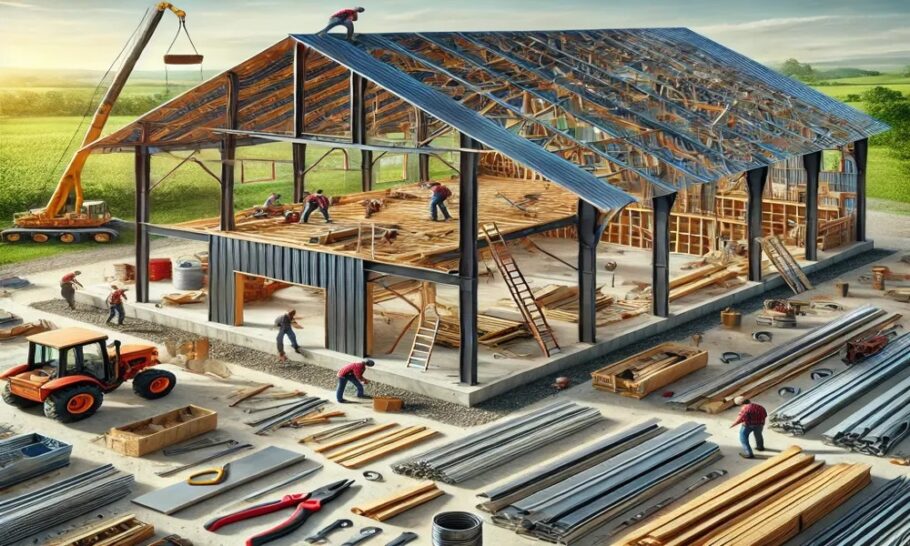Barndominiums—those versatile steel-framed structures that blend the durability of barns with the comfort of modern homes—have gained popularity across the U.S. and beyond. While their adaptability, cost-efficiency, and unique aesthetic appeal make them attractive options for homeowners, one crucial aspect often determines their long-term success: structural design for environmental loads.
Wind and snow loads are two of the most significant forces that can impact a barndominium. Failing to account for them properly can result in costly damage, reduced energy efficiency, or even structural failure. Whether you are building in hurricane-prone Florida, tornado alley in the Midwest, or snowy regions like Montana or Colorado, understanding how to design for these loads is non-negotiable.
This blog post explores how wind and snow loads affect barndominium construction, the key design principles involved, and practical strategies to ensure your structure remains safe, functional, and long-lasting.
Why Wind and Snow Loads Matter
Barndominiums differ from traditional wood-framed homes because they often rely on steel frames and large, open spans. While these provide flexibility in floor plans, they also make the structure more vulnerable if not engineered properly.
- Wind loads refer to the pressure and forces exerted by moving air on the surfaces of a building. These loads vary depending on the structure’s shape, orientation, and local wind conditions. High winds can lead to roof uplift, wall deformation, or even complete collapse.
- Snow loads refer to the weight of accumulated snow and ice on the roof and other horizontal surfaces. Heavy snow can stress roof trusses, cause sagging, or trigger collapse if the load exceeds the design capacity.
When designing a barndominium, accounting for these forces is about more than meeting code requirements—it’s about protecting lives, investments, and ensuring your home’s resilience.
Understanding Building Codes and Standards
Before diving into structural solutions, it’s essential to recognize that local building codes dictate minimum requirements for wind and snow loads. These codes are typically based on standards such as:
- ASCE 7 (Minimum Design Loads and Associated Criteria for Buildings and Other Structures)
- International Building Code (IBC)
- Local or regional amendments for areas prone to hurricanes, tornadoes, or heavy snowfall.
For example:
- In coastal areas, wind design might require resisting speeds up to 140–180 mph.
- In northern climates, roofs might need to withstand snow loads exceeding 50 pounds per square foot (psf).
Working with a licensed engineer ensures that your barndominium is tailored to your exact location and climate zone.
Designing for Wind Loads
- Structural Framing and Bracing
Steel frames are naturally strong against lateral forces, but large open spans must be reinforced. Cross-bracing, rigid frames, and shear walls can help redistribute wind forces throughout the structure.
- Roof Design and Uplift Resistance
Roofs are the most vulnerable part of a barndominium during high winds. Gabled roofs with steep pitches tend to catch more wind, while low-slope or hip roofs offer better resistance. To prevent uplift:
- Use hurricane clips or steel fasteners to secure trusses.
- Anchor roof panels with screws instead of nails.
- Ensure proper overhang length (shorter overhangs reduce uplift risks).
- Foundation and Anchoring
A strong connection between the steel frame and foundation is critical. Anchor bolts, embedded plates, and reinforced concrete footings help transfer wind forces safely to the ground.
- Openings and Pressure Management
Windows and doors are weak points. If wind enters the interior, it creates internal pressure that can double stress on walls and roofs. To mitigate this:
- Use impact-resistant windows in hurricane zones.
- Install doors rated for high-wind performance.
- Avoid large, unreinforced openings facing prevailing winds.
Designing for Snow Loads
- Roof Pitch and Shape
Roof slope plays a major role in snow accumulation.
- Steeper slopes (above 4:12 pitch) shed snow more effectively.
- Low slopes may require extra reinforcement since snow can accumulate evenly.
- Shed roofs can be particularly effective in snowy regions if designed with proper drainage.
- Structural Support for Roofs
Trusses and purlins must be engineered to carry expected snow loads. In areas with extreme snowfall, using heavier gauge steel or reducing truss spacing can prevent sagging.
- Snow Drift Considerations
Wind can cause snow to drift unevenly, leading to higher concentrations in certain areas like roof valleys, near chimneys, or along taller adjacent walls. Engineers often design for unbalanced snow loads to account for these irregularities.
- Ice Dams and Water Management
Improper insulation or ventilation can cause snow to melt unevenly, leading to ice dams along roof edges. These dams can damage roofing materials and cause leaks. Solutions include:
- Proper attic ventilation.
- Insulating roof decks to maintain uniform temperatures.
- Installing ice and water shield membranes under roofing.
Balancing Wind and Snow Load Design
One challenge is that solutions for wind resistance can sometimes conflict with snow load requirements. For instance, a steep roof pitch is excellent for snow shedding but may increase wind uplift. A low-slope roof resists wind better but risks snow buildup.
The key is site-specific design:
- In windy but low-snow areas (e.g., coastal Texas), a low-slope roof may be ideal.
- In snowy but less windy areas (e.g., Minnesota), a steep-pitched roof makes more sense.
- In areas with both risks (e.g., Colorado’s Front Range), hybrid solutions like reinforced steep roofs with extra anchoring are necessary.
Practical Tips for Homeowners
Even if you aren’t an engineer, you can play a role in ensuring your barndominium is safe. Here are some tips:
- Know your site conditions. Request wind and snow load data from your local building department before finalizing plans.
- Hire experienced designers and builders. Not all barndominium kits or builders account for regional load differences.
- Don’t cut corners on materials. Using lighter-gauge steel, cheaper fasteners, or non-rated windows may save upfront costs but can lead to catastrophic failure.
- Consider future-proofing. With climate change, extreme weather events are becoming more common. Designing for higher-than-required loads may add resilience.
- Maintain your structure. Inspect roof connections, anchors, and exterior cladding regularly to catch small issues before they become big problems.
Conclusion
Designing a barndominium isn’t just about floor plans, finishes, and rustic charm—it’s about creating a structure that stands firm against the forces of nature. Wind and snow loads are two of the most critical environmental considerations in barndominium construction. By following building codes, working with qualified engineers, and carefully balancing structural solutions, you can build a home that is not only beautiful and functional but also safe and durable for decades to come.
When planning your barndominium, remember this: while aesthetics can be changed later, the structural design is permanent. Getting it right the first time ensures peace of mind, comfort, and long-term value.

